The renaissance genius Leonardo da Vinci has given us immortal masterpieces. With them a multitude of mysteries: we can mention the enigmatic smile of the Mona Lisa, her controversial identity, or the extraordinary machines Leonardo designed. And more: the lost Battle of Anghiari, an obsession for those trying to find it under the plaster of Palazzo Vecchio. Some scholars even believe Leonardo was the creator of the Holy Shroud… Nobody could imagine the existence of a new and modern enigma, characterized by many contradictions.
Like a sudden bolt of lightning in the sky, like an actor on the stage, the Salvator Mundi appeared. Indeed, in 2011, an exhibition at the National Gallery in London revealed to the world the discovery of a new alleged masterpiece by Leonardo.

The enigma
Critics knew the existence of the painting and when it was found many of them were not surprised. The presence in history of a Salvator Mundi by Leonardo was known from secondary sources: preparatory studies, copies by the master’s students, indirect testimonies. Czech graphic artist Wenceslaus Hollar probably saw the work in the 17th century, and made a reproduction using the etching technique. Hollar’s engraving is similar to the Salvator Mundi we now know. However, there is no historiographical document that reveals this Salvator Mundi to be Leonardo’s own, nor its commissioner.
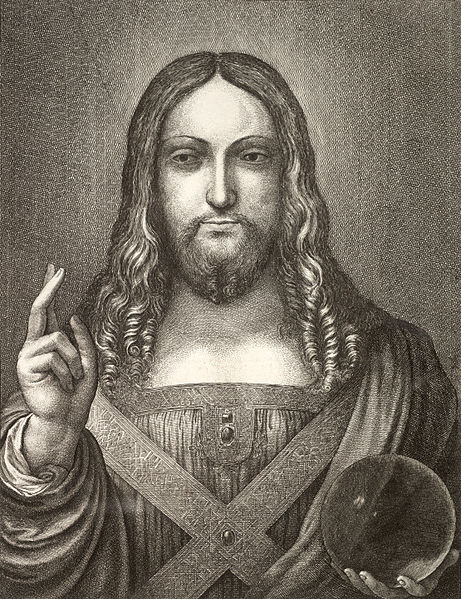
The attribution therefore raises some doubts. Is the Savior of the World that we know a work made by Leonardo or one of his pupils? Some scholars hypothesize that it is a work by Boltraffio, others by Bernardino Luini, and still others by Francesco Melzi… It is an ongoing debate that will take more time to settle. Unfortunately, no one can investigate the matter further because the painting is once again mysteriously lost.
The uncertain history of the Savior of the World painting
Allegedly Hollar saw the Salvator Mundi in London. The painting could be among the treasures of Charles I Stuart, a great collector and admirer of Italian art. But how did the painting get to England, if it was Leonardo’s original masterpiece? Supporters of the attribution to Leonardo have argued that the Salvator Mundi arrived in London for the wedding between Charles I and Enrichetta Maria, daughter of the French king Henry IV, in 1625. According to them, the work was in France because Leonardo had given it to King Louis XII. After the death of Charles I Stuart, his collection was dispersed.
Beginning in the seventeenth century there is a historiographical void on the painting. A similar Savior of the World, perhaps a copy by Marco d’Oggiono, Francesco Melzi or Boltraffio, is mentioned in the collections of Francis Cook. After various controversies this picture arrived in Paris – it was acquired by the Marquis de Ganay1 – and is considered in France to be the real painting by Leonardo, an authenticity also supported by one of the greatest scholars of the Renaissance genius, Carlo Pedretti.
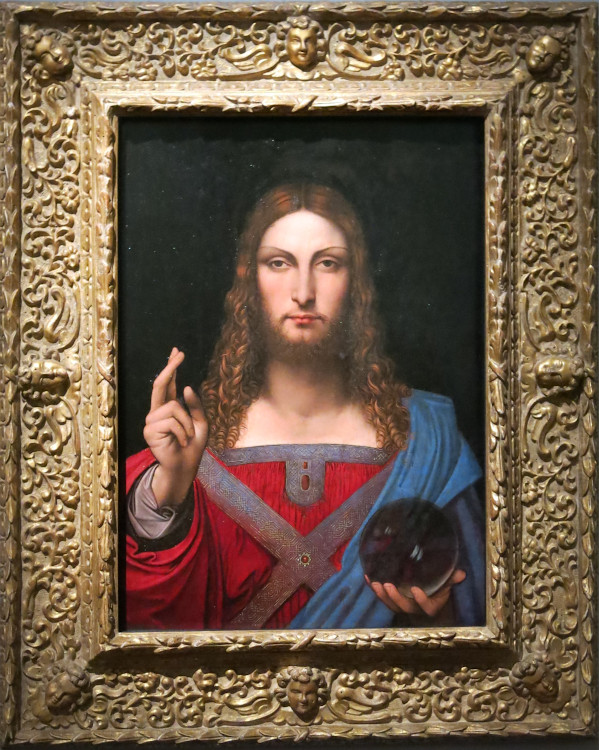
The vicissitudes of the painting
Anyway, Leonardo’s Salvator Mundi was already missing at that time. Pierluigi Panza argues that Leonardo’s work was purchased by John Stone, and only later, in 1659, delivered to Charles II Stuart. It was inventoried with the words: “Leonard de Vince our Savior with a globe in one hand and holding up the other“. Afterwards the painting passed from the Stuarts to the lover of King James, Catherine Sedley, and then, due to another marriage, to the Sheffields. The Sheffields sold at auction the painting, in 1763, for two pounds.
It is said that the Salvator Mundi was acquired by William Blake, and this would be deduced from a confidence that the scholar made in 1778 to George Cumberland. Cumberland was one of the most important art men in England, member of the Royal Academy and founder of the National Gallery of London. These are, however, mere suppositions and posthumous reconstructions. It seems, in fact, that no one could remember where the Savior of the World was located, or what its inestimable value was.
Traces of the painting were completely lost, as a result of controversial changes of ownership and donations, at least until 1958. Only then did a version of the Salvator Mundi reappear with a false moustache and beard, the result of a modification to adapt the work to the canons of the Counter-Reformation and the classical iconography of Christ. In 1958 the painting was sold at auction by Sotheby’s to an American collector for 45 pounds.
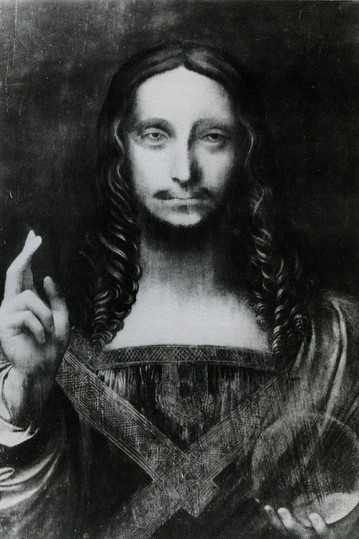
The Announcement
The recent history of the Salvator Mundi began in 2005 when the work was purchased by Robert Simon, an art collector, for ten thousand dollars. Simon believed that it was a minor work, and that the real masterpiece was the one by de Ganay, preserved in France.
However, when he entrusted the painting to the National Gallery in London, so that its value could be estimated and it could be restored, the imponderable happened. As soon as the restorer Dianne Dwyer Modestini, senior research fellow and conservator at New York University, had begun her work, she started to suspect that the Salvator Mundi could be a work by Leonardo. Of the same opinion were the expert Mina Gregori, of the University of Florence, and Sir Nicholas Beaver Penny, director then of the National Gallery in London. The use of the technique of sfumato led to think of the genius of Leonardo da Vinci.
Hence, in 2010 the clamorous announcement was made: Penny invited three distinguished scholars to the National Gallery, who declared that the painting was the lost masterpiece of Leonardo. They were Pietro Maraini and Maria Teresa Fiorio, essayists from Milan and experts on Leonardo, and Martin Kemp of Oxford University. Carmen Brambach, curator of the department of graphic art at the Metropolitan Museum of New York, was of a different opinion; she recognized the Savior of the World as a painting by Boltraffio.
Despite the opposition of Brambach and other illustrious scholars, including Carlo Pedretti, the clamor aroused by the National Gallery’s announcement was enough to grant an extraordinary fame to the Salvator Mundi. Consequently, the painting was restored by removing the Counter-Reformation additions, including the moustache and beard, and revealed an extraordinary pictorial mastery.
An international intrigue
From that moment on, the Salvator Mundi was the subject of international intrigue and controversial, even fraudulent, exchanges. The story of the painting sometimes resembles a gripping espionage thriller. It was purchased for $127 million by Russian tycoon Rybolovlev, an art lover known for owning the AC Monaco soccer team. The sale took place through the intermediary of a Swiss agent whom Rybolovlev later sued. The tycoon has claimed to have been cheated of one billion euros regarding negotiations and transfers of artworks: several paintings by Picasso, Modigliani and even the Salvator Mundi. International investigations are still in progress.
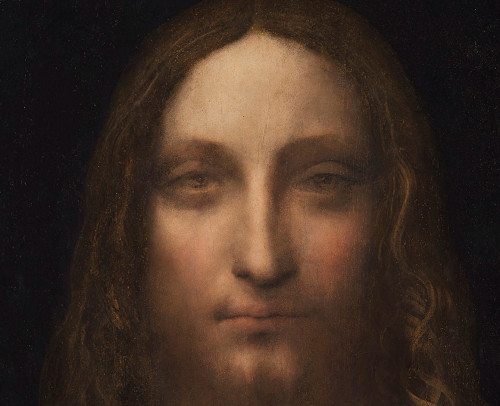
A millionaire auction
In November 2017, Rybolovlev entrusted the Salvator Mundi to the famous Christie’s auction house in order to sell it for the highest possible price. Certainly, the Russian tycoon did not imagine the exorbitant value at which the painting was sold; a mysterious businessman bought the work for $450.3 million and Leonardo’s Salvator Mundi became the most expensive painting in the world. Therefore, people began to wonder who could be so rich. The identity of the buyer has never been revealed with certainty, but numerous clues suggest that it might be Saudi Prince Bader bin Abdullah bin Farhan Al Saud, perhaps on behalf of the Crown Prince of the United Arab Emirates, Mohammed bin Salman2.
The disappearance of the Savior of the World
In 2018, the Abu Dhabi Louvre had announced a permanent exhibition of the work, but this never happened, and since then no one knows what has happened to the Savior of the World. Authorities from Abu Dhabi’s Department of Culture and Tourism, questioned repeatedly on the issue, refuse to provide more information. Some people suggest that the painting is in Geneva, at a free port, where it would be exempt from international duties. Another suggestion is that Abu Dhabi art critics are still considering whether the work is a forgery or a Leonardo original.
Is the Savior of the World a fake?
The Salvator Mundi is a small oil on walnut panel of 66×45 cm, it shows a blessing Christ. The gaze is turned toward the viewer, and the pose follows the classical iconography. Christ makes the sign of the cross with his right hand, while in the other he holds a transparent globe, a symbol of sovereignty over the whole earth. The globe is made by the painter transparent and reproduces an optical effect of refraction. The work is characterized by great technical precision on the details of the tunic, blue and brown, and the use of sfumato, as evidenced on the face and hair. These are two distinctive features of Leonardo, but also of all his pupils.

Controversial details
However, a detail that can not be ignored is the absence of the background; Leonardo used to paint in his paintings a distinctive landscape, as in the Mona Lisa or the Virgin of the Rocks. This feature is absent in Salvator Mundi, rather there is a dark black background, which is totally pervaded by an absence of shadows. Even the globe has been the focus of controversy: Leonardo was a great expert in optical phenomena and knew that glass or crystal lenses produce inverted and enlarged images, but none of this is observable in Salvator Mundi.
Conversely, some analyses conducted on the pigments of the drapery reveal a chemical compatibility with the colors used in other paintings by Leonardo. Moreover, the Salvator Mundi seems to be comparable with some preparatory studies of the Florentine genius, now preserved in the Royal Library of Windsor Castle.
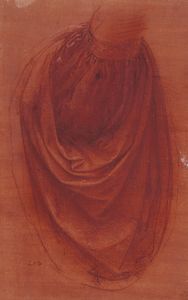
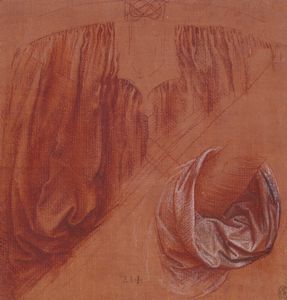
Some scholars, therefore, believe that the Savior of the World is a work by Leonardo, while others believe that it should be attributed to the master’s pupils, such as Boltraffio, Bernardino Luini or Francesco Melzi. Carlo Pedretti, the world’s leading expert on Leonardo, stated: “We are facing a sophisticated marketing operation that is promoting as an original by Leonardo what it is not…. Just look at it”3. Carmen Bambach, Frank Zöllner4 and Michael Daley5 agree with this thesis.
Another Salvator Mundi
In November 2020, the International Committee Leonardo da Vinci announced that it has found the real Salvator Mundi, based on the studies of Annalisa di Maria, a member of the Unesco Center of Florence: the “painting” by Leonardo would be in Lecco and not in Abu Dhabi. In truth, it is not even a painting, since it is a drawing preserved in a private collection.
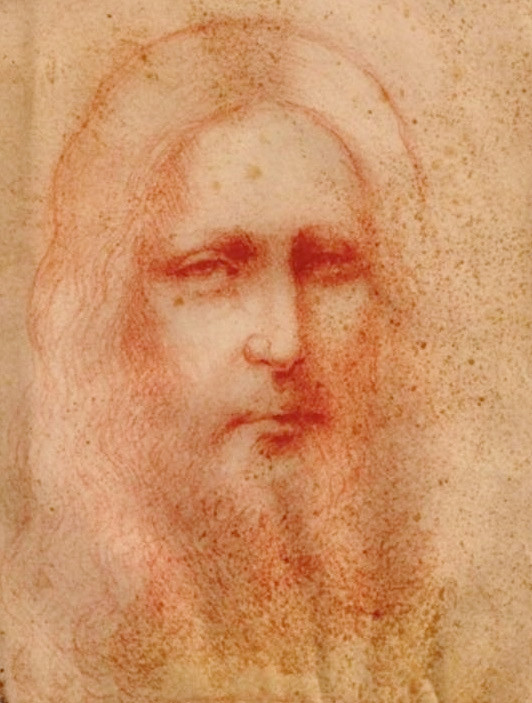
Annalisa di Maria is convinced of the discovery, and points out how “the face depicted is placed in three quarters as most of the subjects painted by the master of Vinci, that is in motion and with an impressive dynamism […]. The real face of the Salvator Mundi […] was probably never painted on the panel and never completed”6. The Salvator Mundi is a mystery still to be revealed.
Samuele Corrente Naso
Notes
- P. Panza, L’ultimo Leonardo. Storia, intrighi e misteri del quadro più costoso del mondo, Utet, 2018. ↩︎
- Saeed Kamali Dehghan, Louvre Abu Dhabi postpones display of Leonardo’s Salvator Mundi, The Guardian 3 settembre 2018. ↩︎
- C. Pedretti, Se Leonardo è una chimera – È errata l’attribuzione del «Salvator mundi», Osservatorio Romano, 2011. ↩︎
- F. Zöllner, Salvator mundi, in Leonardo da Vinci: The complete Paintings and Drawings, Taschen America Llc, 2015. ↩︎
- M. Daley, Problems with the New York Leonardo Salvator Mundi Part I: Provenance and Presentation, 2018. ↩︎
- Discovered a drawing attributed to Leonardo Da Vinci: «It is the real Salvator Mundi, that sold for 450 million dollars is false », Il Mattino, 18 november 2020. ↩︎

